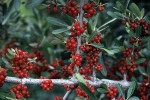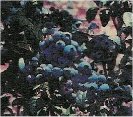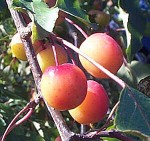 |
CHOKECHERRY
– Prunus virginiana
Chokcherries grow on small trees or shrubs with clusters of red to black fruit They have a tangy, wild flavor. They are also known as wild cherries or chokeberries.
The fruit causes the mouth to pucker thus accounting for the "choke" part of its name. This fruit is native to the northern plains and was highly esteemed by
Native Americans and early settlers. Native Americans dried the fruit to use as food and make into pemmican. It was also ground, formed into cakes and dried in the
sun or the dried berries were added to soups. Today Chokecherries are used for wine, jelly and syrup.
|
 |
BUFFALO BERRY
– Shepherdia argentea
Buffalo Berries grow on an 8-12' thorny shrub. They have silvery foliage and very hardy, orange-red fruits.
They is also known as bullberries and were given this name because buffalo liked this shrub. Berries are gathered after a hard frost.
They are gathered by placing a tarp on the ground and beating the bush so the berries fall from the twigs. The berries were consumed
by Native Americans and early settlers. They were used raw, dried, for juice to drink and added to soups and stews. The berries also
were used to replace chokecherries in pemmican. Today we enjoy Buffaloberries in jelly and syrup.
|
 |
JUNEBERRY
– Amelanchier alinfolia
Also known as Saskatoon or Serviceberry. It grows on bushy hillsides and creek banks.The berry is native to ND, SD,
Wyoming, Montana and Canadian Provinces and was a major food for many Native American
Tribes. They were harvested in quantities by shaking the bushes and collecting the berries on blankets. They were used fresh or dried and
used in pemmican. They still grow wild today and are also produced commercially. Favorite uses are for pie, jelly, jam
and syrup.
|
 |
WILD CRANBERRIES
– Viburnum opulus
Also known as high-bush or American Cranberry. A very hardy shrub with bright red berries. The plant is inappropriately named since the berry is nothing like a cranberry.
The Native American Name was Summer-Berry which was translated to Pembina by the Americans. The berries grew in abundance along the
Summer-Berry or Pembina river in Northeastern North Dakota. The fruits were used fresh for food and not gathered in quantity and
preserved. The blossoms were seeped in hot water to produce a favored drink. The stalks were used as popguns by young children.
They make an excellent tasting jelly or syrup.
|
 |
WILD PLUM
– Prunus amreicana
Wild Plums grow on tress that are 3 to 24 ft. tall and are covered with yellow-red fruit in late summer. They usually grow in thickets and the branches are spinney.
They are found on the prairies, in woods, pastures and along riverbanks. This fruit was highly valued by Native Americans and was eaten fresh or raw or cooked for sauce. The
plums were also dried for winter use. Many tribes planted their corn, beans and squash when the plums came into bloom in
the spring. Many tribes tied plum branches together and used them as brooms . Today they are used fresh and for jelly, jam or syrup.
|
 |
CRAB APPLES
– Malus ioensis
Early history indicates that Crab Apples were found only in the southeastern part of Nebraska along the Missouri River. The appearance of these trees in the Northern Plains
indicates plant migration by humans. Native tribes used the fruit for food if they were familiar with it. Today Crab Apple trees are
primarily ornamental although they do make an excellent, tart jelly.
|
 |
RASPBERRIES
– Rubus idaeus
Raspberries originally grew wild and there are areas where they still grow wild today. Native Americans used the berries for fresh fruit or them
dried for winter use. The young leaves were boiled for a tea-like drink. Raspberries are a favorite fruit for jams today.
|
 |
RHUBARB
– Rhuem rhubarbaum
Rhubarb is also known as Pieplant. It is a perennial vegetable that originated over 2000 in Asia. It was not grown for culinary purposes until the 18th century and
early settlers introduced rhubarb to the plains. Although rhubarb is a vegetable it is generally prepared as a dessert food and make
excellent pies, sauces and jams.
|















